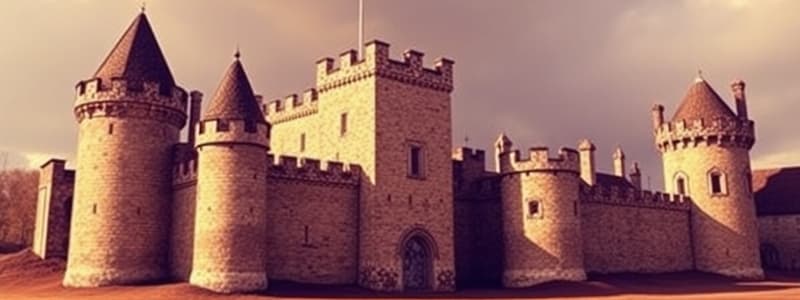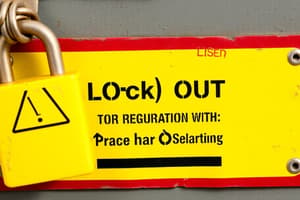Podcast
Questions and Answers
What was the purpose of building castles across England after the Norman Conquest? 3 correct responses
What was the purpose of building castles across England after the Norman Conquest? 3 correct responses
- To stop foreign invaders. (correct)
- To stop Anglo-Saxon rebellions. (correct)
- To act as a center for trade and commerce.
- To serve as a symbol of Norman power and control. (correct)
What was the name of the Norman castles?
What was the name of the Norman castles?
- Motte and Bailey (correct)
- Moat and Bailey
- Motte and Balley
- Moat and Balley
What was the main objective behind the Domesday Book?
What was the main objective behind the Domesday Book?
- To create a comprehensive map of England.
- To establish a legal system for the newly conquered England.
- To determine the amount of taxes each person owed. (correct)
- To record the history of England before the Norman Conquest.
Why was the Domesday Book considered a powerful tool for William the Conqueror?
Why was the Domesday Book considered a powerful tool for William the Conqueror?
What does the term 'Harrying' refer to in the context of the Norman Conquest?
What does the term 'Harrying' refer to in the context of the Norman Conquest?
What was William's primary motivation for the Harrying of the North?
What was William's primary motivation for the Harrying of the North?
What was the impact of the building of castles on the lives of the Anglo-Saxon people? Two correct answers
What was the impact of the building of castles on the lives of the Anglo-Saxon people? Two correct answers
How did the Domesday Book contribute to the Normans' control over England?
How did the Domesday Book contribute to the Normans' control over England?
What was the main purpose of the Harrying of the North?
What was the main purpose of the Harrying of the North?
What role did Queen Matilda play in the Norman conquest? 2 correct responses
What role did Queen Matilda play in the Norman conquest? 2 correct responses
Which of these was NOT a direct consequence of the Feudal System?
Which of these was NOT a direct consequence of the Feudal System?
How did the Domesday Book help the Normans maintain control over England?
How did the Domesday Book help the Normans maintain control over England?
What was the main reason why the Normans' control over England lasted for many years?
What was the main reason why the Normans' control over England lasted for many years?
What was the role of knights under the Feudal System?
What was the role of knights under the Feudal System?
Which of these best describes the relationship between the king and the barons under the Feudal System?
Which of these best describes the relationship between the king and the barons under the Feudal System?
What was the main purpose of the Feudal System? 2 correct answers
What was the main purpose of the Feudal System? 2 correct answers
How did the Harrying of the North differ from the other methods used by the Normans to maintain control of England?
How did the Harrying of the North differ from the other methods used by the Normans to maintain control of England?
What is the definition of 'harrying'?
What is the definition of 'harrying'?
What does scorched earth mean?
What does scorched earth mean?
When was the Domesday book completed?
When was the Domesday book completed?
Flashcards
William the Conqueror
William the Conqueror
The Norman leader who invaded England in 1066 and won the Battle of Hastings.
Battle of Hastings
Battle of Hastings
The battle in 1066 where William defeated the Anglo-Saxon King Harold II.
Motte and Bailey Castle
Motte and Bailey Castle
A type of castle with a raised mound (Motte) and an enclosed courtyard (Bailey).
Role of Castles
Role of Castles
Signup and view all the flashcards
Domesday Book
Domesday Book
Signup and view all the flashcards
Purpose of the Domesday Book
Purpose of the Domesday Book
Signup and view all the flashcards
Harrying of the North
Harrying of the North
Signup and view all the flashcards
Consequences of Harrying
Consequences of Harrying
Signup and view all the flashcards
Norman Control Methods
Norman Control Methods
Signup and view all the flashcards
Famous Norman Castles
Famous Norman Castles
Signup and view all the flashcards
Queen Matilda
Queen Matilda
Signup and view all the flashcards
Feudal System
Feudal System
Signup and view all the flashcards
Role of the King
Role of the King
Signup and view all the flashcards
Barons (Lords)
Barons (Lords)
Signup and view all the flashcards
Knights
Knights
Signup and view all the flashcards
Peasants
Peasants
Signup and view all the flashcards
Impact of the Harrying
Impact of the Harrying
Signup and view all the flashcards
Method of Control
Method of Control
Signup and view all the flashcards
Study Notes
Norman Control of England after 1066
- William the Conqueror, after winning the Battle of Hastings, implemented various strategies to maintain power. Anglo-Saxons resistance was a factor in these strategies.
Castles: Strongholds of Power
- Over 500 Motte and Bailey castles were constructed rapidly across England.
- Motte and Bailey castles consisted of a tall hill (Motte) with a tower and a lower fenced area (Bailey) for troops and resources.
- Castles were strategically placed in towns and villages to suppress potential rebellions, and were also symbols of power.
- Many castles were later built of stone, enhancing their strength (e.g., Tower of London, Durham Castle, Warwick Castle).
Domesday Book: Comprehensive Knowledge
- William the Conqueror ordered a detailed survey of England called the Domesday Book in 1086.
- This survey recorded land ownership, livestock count, and tax obligations.
- William aimed to prevent wealth concealment and accurately collect taxes.
- The Domesday Book demonstrated William's comprehensive control over his kingdom. It was called the "Doomsday" book because once recorded there, information wasn't altered, like on Judgement Day.
Harrying of the North: Brutality and Suppression
- In 1069-1070, Anglo-Saxon rebels in northern England were met with brutal suppression, known as the Harrying of the North.
- This involved systematic destruction—burning villages, killing people, devastating crops, and livestock—rendering the land unusable.
- This aimed to punish rebels and demoralize potential future opposition.
- Northern England suffered long-term devastation from famine and abandonment (long-term empty areas).
Matilda, Queen and Regent
- Queen Matilda of Flanders, William's wife, was a crucial ruler when William was absent, acting as a regent.
- She managed aspects of government, including taxes, laws, and administration.
- Matilda backed the building of churches and abbeys, aiding in spreading Norman culture.
- She was a significant ruler with coronation rites similar to the King, showcasing her influence.
Feudal System: Organization of Power
- The Feudal System structured Anglo-Saxon England under Norman rule.
- The Feudal system worked on a hierarchy—The King owned all the land and distributed it to loyal barons (lords) for military service.
- Barons governed large estates (manors), supplied knights to the royal army, and collected taxes.
- Knights supported barons, protecting their land, and serving in the king's army whenever needed.
- Peasants (serfs/villeins) worked the land in return for protection and paid taxes. Peasants often couldn’t move from their lord's land.
- The system ensured Norman control by connecting all levels, from the highest to the lowest level of society, under the rule of the King.
Summary of Norman Control
- Castles asserted Norman authority
- The Domesday Book revealed Norman administration and control
- The Harrying of the North showcased Norman power and ruthlessness.
- Matilda strengthened Norman rule as regent
- The Feudal system incorporated all the people under Norman rule effectively.
Studying That Suits You
Use AI to generate personalized quizzes and flashcards to suit your learning preferences.



